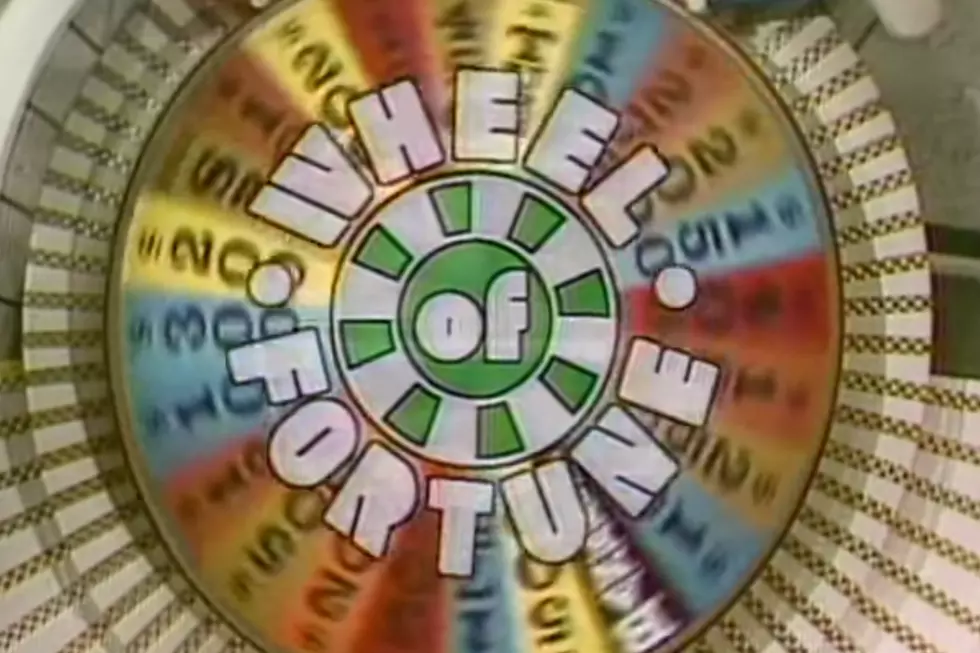
45 Years Ago: ‘Wheel of Fortune’ Makes Its Television Debut
On Jan. 6, 1975, the first episode of Wheel of Fortune hit the airwaves. It would become a massive success, hailed among the most popular game shows in television history -- though no one can fully explain why.
Wheel of Fortune was the brainchild of Merv Griffin, the same television luminary who created Jeopardy more than a decade earlier. Emboldened by the success of that program, the media mogul pondered other game-show ideas. Recalling long car rides in his youth when he’d play Hangman with his sister, Griffin began developing a new word-game concept.
"One day during a production meeting in the mid-'70s, I told my staff about my childhood memories of playing Hangman," Griffin recalled in his autobiography. "They all thought it had great potential as a game show, but that it needed a gimmick or 'hook' in order to succeed on television."
That's when the wheel popped into his head. "During all those years that I did The Merv Griffin Show at Caesars Palace, surrounded by blackjack and craps tables, it was always the big spinning wheel that I was drawn to," the TV veteran explained. "It drove me crazy. I could never win on it, but I still loved to play."
Convinced that the wheel would be his winning gimmick, Griffin pitched the idea to NBC executives. The network greenlit the show with one suggestion: Add a shopping element. As such, the initial project was called Shopper’s Bazzaar. Chuck Woolery hosted the pilot, which was very different from the final product fans have come to love. For starters, contestants were given a list of prize options and chose what they’d be playing for. Shopper's Bazaar also had a vertically mounted wheel, which spun automatically rather than by the contestants.
Watch a Scene From 'Shopper's Bazaar'
Though the show was somewhat clunky, Griffin and the executives saw potential in the initial effort. Changes were made, with actor Edd Burns briefly brought on board as host before producers decided to go back to Woolery. Model Susan Stafford became the show’s first letter turner. The wheel was turned flat and made more visually appealing for the TV audience.
The colorful contraption was also given top-billing, as the show’s name was officially changed to Wheel of Fortune.
Watch a Scene From 'Wheel of Fortune'
Like many game shows, Wheel began its life as a daytime program. It was an immediate success for NBC, airing on the network from 1975 to 1989. Woolery departed in 1981 after a contract dispute, with Stafford soon following him out the door. Griffin replaced them with two relative unknowns, Pat Sajak and Vanna White.
"Vanna’s picture was one of 10 on my desk," Griffin explained to the Los Angeles Times. "I pointed to it and said, ‘Her.’ Why? Because her head’s too big for her body. When you look at her 8x10s, her head’s so big that all of her features -- her mouth, her great big eyes -- all stand out. The camera loves her!"
Enlisting Sajak wasn't as easy. “I went to NBC and asked for Sajak for Wheel of Fortune,” Griffin noted. “And they said, ‘No, no, no! He’s a weatherman." Despite the network's reluctance, the TV legend recruited his host.
“When Wheel came on, I was doing the local news at KNBC Los Angeles,” Sajak recalled in a 2012 interview with Broadcasting + Cable. “I had been offered two prime time series on NBC -- Real People and Speak Up America -- but I said no. … A short time after that, Merv Griffin offered me Wheel of Fortune, which was only airing on network daytime at that point. A little bit of it had to do with Merv. And to be honest, my thinking at that time was that the show had already been on seven years and was finishing third in its time slot behind Price Is Right on CBS and reruns of Love Boat on ABC. I thought I’d do Wheel for another year or two and then I would have established national credibility and would move on.”
Instead, the duo of Sajak and White would become synonymous with Wheel of Fortune over the subsequent decades, with both hosts eclipsing 7,000 episodes.
Still, the unquestioned star of the show was the wheel itself. The colorful centerpiece added a Vegas-style glitz to the game, just as Griffin envisioned. The first incarnation was made of cardboard, paint and light bulbs. Even as new technology has been integrated into the unit, the same wheel frame has been used since the show’s first airing. The modern version -- made of steel, Plexiglas and LED lights -- measures more than seven feet in diameter and weighs more than 12,000 pounds.
In September 1983, a syndicated nightly version of Wheel of Fortune debuted. According to Griffin, the show tested "terribly." The program launched in approximately 50 cities -- a relatively low number for a production of its size -- and none of the top three television markets. Despite this inauspicious beginning, the syndicated Wheel quickly became one of the most popular programs in the country.
Watch a 1985 Report on 'Wheel of Fortune'
By 1986, Wheel of Fortune had become the top-rated syndicated show in America. Even as the daytime version changed networks and was eventually canceled, the syndicated version remained a nightly powerhouse. Hardcore fans of the show called themselves "wheelies." Sajak and White became pop-culture celebrities. And the program was dubbed "America's Game."
"I really haven't the foggiest idea why we're so big," Sajak confessed in a 1986 conversation with the St. Petersburg Evening Independent. "Now, I can point to elements that make it successful: It's a good game, easy to play, kind of compelling. If you walk past the television set, you almost have to play along."
In a mid-’80s article penned for the Los Angeles Times, writer Howard Rosenberg pondered the secret to Wheel’s popularity. “Wheel of Fortune is the Lawrence Welk of game shows, still a corny polka after all these years,” the journalist surmised. “It’s unimaginative and undemanding, and perhaps that’s the ticket. TV audiences seem to crave simplicity as a release from reality. So what if the world you faced today was increasingly complex and fragile, ready either to explode or shatter? So what if the rat race was rattier and the frustrations larger than ever? Tonight we’ll spin the wheel with Pat and Vanna, fill in the blanks and vicariously pick up the prizes.”
While Rosenberg’s reasoning can be debated, his observation was spot-on. Regardless of social or political climates, viewers continued tuning in to Wheel of Fortune. Through various fads and changing technology, the show has remained a mainstay on national television. It's a phenomenon Sajak is keenly aware of, the host admitting such during a 2019 interview with USA Today. "We’re sort of a safe-haven half hour where nobody gets hurt and everybody has fun," the host noted. "If I went in to pitch this show to a network today, the pitch would last about eight seconds, and they’d go, 'Thank you, next,' 'cause it’s old-fashioned."
That’s not to say that the show is unchanged. Producers have tweaked various aspects of the program over the years in an effort to keep Wheel of Fortune both familiar and updated. Wild cards and a bonus round were introduced. The show celebrated things like "celebrity week," "college week" and "NFL players week." Meanwhile, the shopping segments were eventually removed, something Sajak was happy to see go. “They were the dullest moments on television,” the host once said. “We would have been gone a long time ago if that hadn’t changed.”
Another update are the off-screen digital monitors that display the number of consonants in each respective puzzle. In the show's early years, hosts had to depend on production staff holding up fingers to convey this information. "They came to be known as 'finger boys,'" Sajak explained to ABC News. "Because someone would say, 'Are there any Bs?' And someone would have the puzzle in front of them and go [holds up two fingers], and I would say, 'There are two Bs!'"
Board games, video games and slot machines are just some of the many successful merchandising efforts that have taken the Wheel of Fortune brand beyond the TV screen. International versions of the game show have aired in more than 50 countries. Since then, the show has spread its fan base across multiple generations.
“One of the things we’ve found so gratifying is that we hear from young moms that their kids are bringing them back to Wheel of Fortune, and they are going along willingly because Wheel is family-friendly and a safe haven for families who want to watch TV together,” noted the show’s current executive producer, Harry Friedman. “It feels good to be revered in that way and to have been around long enough for us to have become a legacy for our viewers.”
“Playing hangman is really what we are doing, but the show has impacted people in ways we never intended,” admitted Sajak. “People have taken our show into their hearts and made it a part of their lives. That’s very flattering.”
More From 98.3 The Snake










